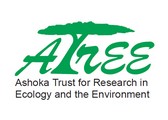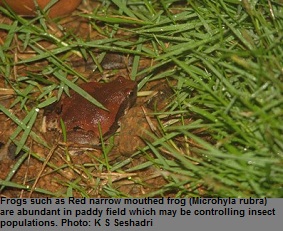Any and all opinions expressed in this newsletter are solely those of the author(s) and do not reflect the opinion of ATREE.
Centre for Excellence in Conservation Science
Royal Enclave,Srirampura,Jakkur Post
Bangalore-560064
Telephone: 080-23635555 (EPABX)
Fax : 080- 23530070
Frogs and toads are among the common animals that most of us saw when we were young. They were commonly seen near houses and gardens and the constant croaks were the usual company at night. Today, this has very much disappeared in the urbanized places that we live. If one needs to find some frogs, the best places would be to reach the nearest wetland, tank, pond or paddy fields. Paddy fields, in some sense - a type of wetland, offer continuous availability of moisture to frogs and in turn serve as breeding grounds. However, they face trouble in another form. Paddy yield needs to be high and so, the farmer, is more often thannot, compelled to buy chemicals,pesticides and fertilizers offered at subsidized rates by the Government. The more pesticide used, the more pests being killed seems an impeccable logic. An abuse of the host of largely inorganic chemicals in fact causes much more than just killing pests.
The chemicals dumped into the fields may kill a few pests but it may also be killing other animals that naturally are known to keep pests under control. These chemicals reachthe actual ponds through irrigation channels. Frogs and Toads for instance, are primarily carnivorous and feed mostly on insects. Paddy attracts many unwanted insects termed as pests and the frogs and toads are efficient in feeding on them. How much do we know of these frogs? How much does a farmer know of the frogs and its benefits? Is there an ounce of truth in the traditional knowledge that frogs control pests? These questions were what we set about to study in the paddy fields around KMTR. Fields around KMTR manage to harvest two crops a year and the frogs breed almost throughout the year, except for the parched months of May.
As a preliminary work, we searched for frogs that are supported in the paddy fields. We later caught about 10 frogs of three species and delicately flushed their stomachs using established protocols to see what they eat. Surprisingly, we found them to eat a great diversity of insects. Our study will examine how many from their diet spectrum will qualify as 'Crop pest'. As to know what farmers know of frogs, we set out and released a photographic pocket field guide on frogs and toads of KMTR in Tamil. With the arrival of monsoon, more intensive surveys, both ecological and social will be carried out to solve the question that have been lurking in the mind for a while!
Editorial Team
Editor: Allwin Jesudasan
Associate editor: Rajkamal Goswami
Editorial Review: R. Ganesan, M. Soubadra Devy, T. Ganesh
Design and presentation: Kiran Salegame
A S H O K A T R U S T F O R R E S E A R C H I N E C O L O G Y A N D T H E E
N V I R O N M E N T
Can frogs help reduce chemical inputs into our wetlands?
- K S Seshadri
If you have any suggestions or comments please let us know through the boxes below






